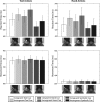Imitation of hand and tool actions is effector-independent
- PMID: 21904930
- PMCID: PMC3183242
- DOI: 10.1007/s00221-011-2852-3
Imitation of hand and tool actions is effector-independent
Abstract
Following the theoretical notion that tools often extend one's body, in the present study, we investigated whether imitation of hand or tool actions is modulated by effector-specific information. Subjects performed grasping actions toward an object with either a handheld tool or their right hand. Actions were initiated in response to pictures representing a grip at an object that could be congruent or incongruent with the required action (grip-type congruency). Importantly, actions could be cued by means of a tool cue, a hand cue, and a symbolic cue (effector-type congruency). For both hand and tool actions, an action congruency effect was observed, reflected in faster reaction times if the observed grip type was congruent with the required movement. However, neither hand actions nor tool actions were differentially affected by the effector represented in the picture (i.e., when performing a tool action, the action congruency effect was similar for tool cues and hand cues). This finding suggests that imitation of hand and tool actions is effector-independent and thereby supports generalist rather than specialist theories of imitation.
Figures


Similar articles
-
Is the observation of the human kinematics sufficient to activate automatic imitation of transitive actions?Behav Brain Res. 2011 Nov 20;225(1):201-8. doi: 10.1016/j.bbr.2011.07.025. Epub 2011 Jul 23. Behav Brain Res. 2011. PMID: 21802449
-
Grasping with tools: corticospinal excitability reflects observed hand movements.Cereb Cortex. 2012 Mar;22(3):710-6. doi: 10.1093/cercor/bhr157. Epub 2011 Jun 17. Cereb Cortex. 2012. PMID: 21685400
-
Mirror neurons responding to observation of actions made with tools in monkey ventral premotor cortex.J Cogn Neurosci. 2005 Feb;17(2):212-26. doi: 10.1162/0898929053124910. J Cogn Neurosci. 2005. PMID: 15811234
-
Movements, actions and tool-use actions: an ideomotor approach to imitation.Philos Trans R Soc Lond B Biol Sci. 2009 Aug 27;364(1528):2349-58. doi: 10.1098/rstb.2009.0059. Philos Trans R Soc Lond B Biol Sci. 2009. PMID: 19620106 Free PMC article. Review.
-
Imitation of a bimanual task in preschool- and school-age children: a hierarchical construction.J Electromyogr Kinesiol. 2012 Aug;22(4):513-9. doi: 10.1016/j.jelekin.2012.01.016. Epub 2012 Mar 4. J Electromyogr Kinesiol. 2012. PMID: 22391341 Review.
Cited by
-
Joint-Angle Coordination Patterns Ensure Stabilization of a Body-Plus-Tool System in Point-to-Point Movements with a Rod.Front Psychol. 2016 Jun 3;7:826. doi: 10.3389/fpsyg.2016.00826. eCollection 2016. Front Psychol. 2016. PMID: 27375518 Free PMC article.
-
Imitation behavior is sensitive to visual perspective of the model: an fMRI study.Exp Brain Res. 2013 Jul;228(2):161-71. doi: 10.1007/s00221-013-3548-7. Epub 2013 May 10. Exp Brain Res. 2013. PMID: 23660743
-
Egocentric mental transformation of self: effects of spatial relationship in mirror-image and anatomic imitations.Exp Brain Res. 2012 Aug;221(1):27-32. doi: 10.1007/s00221-012-3143-3. Epub 2012 Jun 23. Exp Brain Res. 2012. PMID: 22729456
-
Motor resonance in left- and right-handers: evidence for effector-independent motor representations.Front Hum Neurosci. 2013 Feb 13;7:33. doi: 10.3389/fnhum.2013.00033. eCollection 2013. Front Hum Neurosci. 2013. PMID: 23408666 Free PMC article.
-
Action imitation via trajectory-based or posture-based planning.Hum Mov Sci. 2022 Jun;83:102951. doi: 10.1016/j.humov.2022.102951. Epub 2022 Apr 20. Hum Mov Sci. 2022. PMID: 35460956 Free PMC article.
References
-
- Anisfeld M. Neonatal imitation. Dev Rev. 1991;11:60–97. doi: 10.1016/0273-2297(91)90003-7. - DOI
Publication types
MeSH terms
LinkOut - more resources
Full Text Sources

